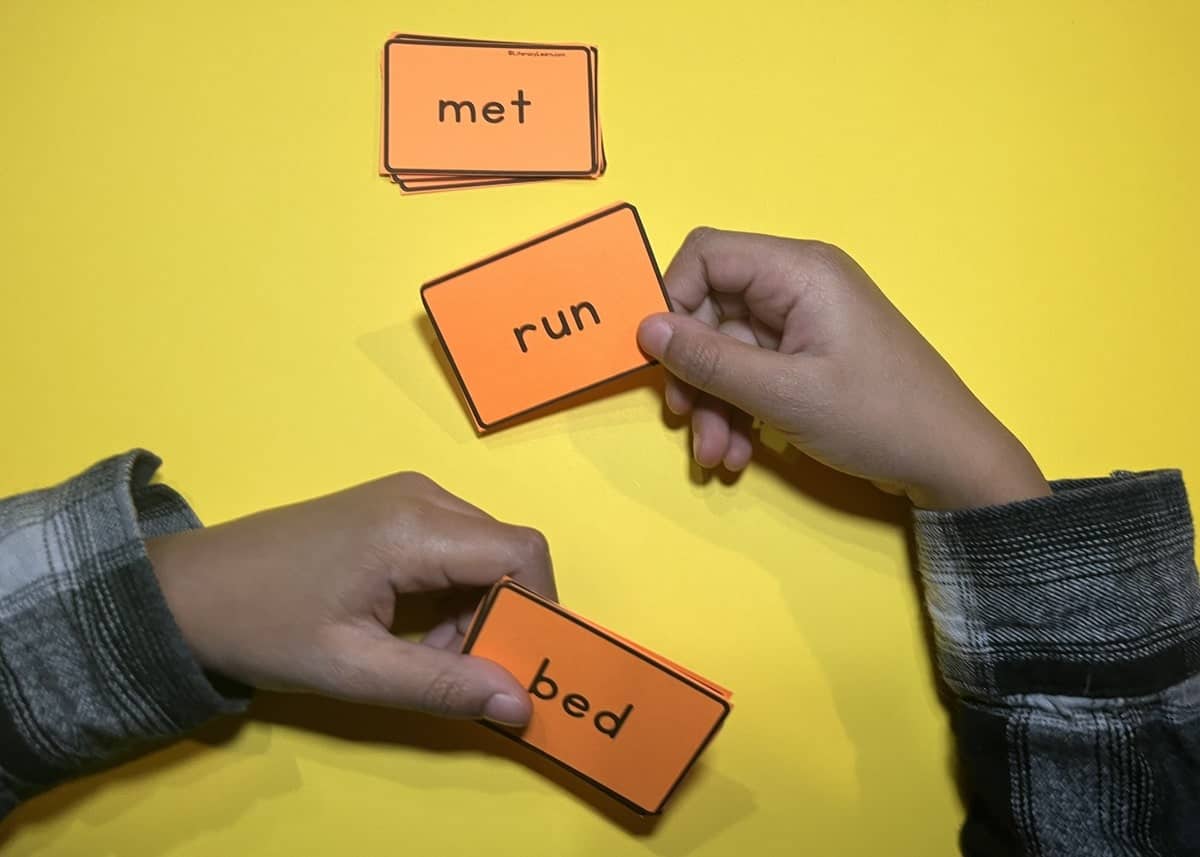100 Free Printable CVC Words Chart & Cards
This post may contain affiliate links. As an Amazon affiliate, we earn from qualifying purchases. See our disclosure policy.
Get 100 free printable CVC words cards with a printable chart to match. Kids will read the words and feel a huge sense of accomplishment as they realize that they have the skills to read 100 total words!

About CVC Words
CVC refers to a three-letter word following this specific pattern: Consonant-Vowel-Consonant. An excellent illustration of a CVC word is ‘dog.’ When spelling ‘dog,’ you start with a consonant (d), followed by a short vowel (o), and then another consonant (g).
CVC words are the perfect transition for beginner readers. Once they know a few letter sounds, they can learn to blend them to read a word.
CVC words are frequently used to teach closed syllables, since the vowel is closed in by a consonant and says a short sound.

100 CVC Words
Below are the 100 CVC words included on the chart and cards.
| tag | bed | met | cat | cop | fig | hum | tug | mat | beg |
| job | map | hot | dog | run | sad | pat | fog | fan | fit |
| tub | jet | fox | pin | cut | gum | jug | pod | tab | ten |
| bus | win | mop | bat | bet | rat | lap | nap | pan | log |
| hat | pot | bug | top | cup | jut | nod | mom | can | rug |
| mum | hut | mud | Ben | sit | rob | pox | hug | hit | max |
| six | van | cap | box | tag | leg | tad | lid | sun | lip |
| dad | lox | dip | zag | hop | bum | wet | dot | net | big |
| sop | pop | vet | mug | jog | hog | kit | hen | wed | wet |
| run | pig | sun | pen | cod | zip | lug | fix | mob | bit |
All words included are real words.
It is also important that kids can read nonsense CVC words, because many multisyllabic words will include nonsense syllables, so practice with closed-syllable nonsense words is definitely recommended as well!
The ability to read nonsense words is the best meausre of phonologic decoding skill in children…[t]he reader literally has to penetrate the sound structure of the word and sound it out, phoneme by phoneme; there is no other way.
Sally Shaywitz, Overcoming Dyslexia (2003)
Nonsense words are important because kids as kids advance, they will need to break apart longer words for accurate decoding (syllabication).
This means they will need to recognize patterns in words, including nonsense syllables. So this way when they come to a VC/CV word like ‘velvet’ they can accurately decode the nonsense syllable ‘vel’ with a short vowel sound.
🙋🏽♀️ Did you know? The closed syllable pattern is important because it is one of the most phonetically-regular patterns in English. That’s why it’s so important for kids to master this syllable type!
Using the Chart & Reading Cards
There are TONS of ways to use these resources. We’ve listed out a bunch of options below.

CVC Chart
The worksheet includes 100 words, which is amazing! But it could be overwhelming for some kids. Visually, it’s a lot.
Some may be up for the challenge, while others may give up before they even start. We will provide some modifications to help you break down for those kiddos who need some extra support.
- Students can read the words, reading from left to right, top to bottom, until they read all 100 words.
- For added support, kids can scan through the words, highlighting each word according to the short vowel. For example, they would scan through, highlighting and then reading all the short a words. Kids can take a break once they’ve read all short a, then move on to short e the next day with a new highlighter color. By the end of the week, all 100 words will be read!
- Use a piece of paper to cover up ALL the words except for those in one line. Not seeing all of the words may help reduce anxiety in some of your struggling readers. You can also use finger highlighters (kids really like these) but just be aware that there is no research supporting using colored overlays for kids with dyslexia.
- Use for fluency practice. Once kids can read the words with relative success, have them use a timer and keep track of how quickly (and accurately) they can read the words. They can read and reread, trying to beat their time!
- Use to practice visual discrimination or auditory discrimination. For example, find all the words that include glued sounds (an, am) or find all the words that start with the /b/ sound.

CVC Reading Cards
As a teacher, flashcards are my best friend! You can use the CVC flashcards for practice with:
- Reading: Kids can practice reading the cards independently, with partners, or with you during small groups.
- Spelling: With partners, have kids pick up the cards one at a time. One child reads the card, and the other spells it using a sheet with elkonin boxes. Then they check each other and see if they match!
- Sorting practice: Have kids use the cards to sort according to short vowels or by word families and then read them in groups.
- Vocabulary: Children can read the word, then flip it over and try to draw a picture to illustrate the meaning.
- Reinforcement: Send the flashcards home to parents so they can practice with their kiddos.
Pro Tip: Gamify the Experience! You can easily gamify the experience by using the flashcards and worksheet together. Just place the flashcards in the middle of the table. One by one, children pick up a card, read it, and then they all search to find the corresponding word on the chart.
🎉 For more ideas to engage students, check out our 25 favorite ways to Make Orton Gillingham Lessons Fun.
Age Group: These flashcards are most appropriate for young readers ages 4-6, usually in Kindergarten or first grade. Be sure to only use this worksheet after kids have been taught all five short vowel sounds. If your students need more targeted short vowel practice, one vowel at a time, grab our no-prep Closed Syllable Workbook!

More CVC Learning Resources
Because CVC words are super important, we have created tons of resources to help make your planning easy and effective! Check out some of our popular CVC resources:
🖨 Download & Print
DOWNLOAD TERMS: All of our resources and printables are designed for personal use only in homes and classrooms. Each teacher must download his or her own copy. Please do not save to a shared drive, reproduce our resources on the web, or make photocopies for anyone besides your own students. To share with others, please use the social share links provided or distribute the link to the blog post so others can download their own copies. Your support in this allows us to keep making free resources for everyone! Please see our Creative Credits page for information about the licensed clipart we use. If you have any questions or concerns regarding our terms, please email us. Thank you!
We’d love to hear about your experience using this resource!
Please leave a comment below or tag us on Instagram @literacylearn!


Thanks for letting me download free cvc words. I am a grandpapa & going to use these for my grandson. Wish you all the best.
Hi there!
We are so happy to hear you can use these to help your grandson learn to decode CVC words!
Katie and Laura